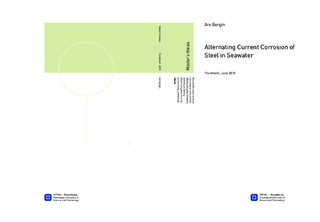| dc.description.abstract | A challenge regarding the transportation of oil and gas in pipelines subsea is to keep the temperature high enough to avoid formation of wax and hydrates, which eventually will stop the flow. In 2000, Nexans introduced a Direct Electrical Heating-system (DEH) that heats up the pipe by applying an alternating current (AC). The problem with applying AC is an increased risk of corrosion. The mechanism of AC corrosion has yet to be fully understood, and there exists limited data on its severity.
The purpose of this thesis is to examine the effect of AC, determine the mechanism of AC corrosion and provide data describing its severity on steel. To achieve this, the following types of steel were investigated through cathodic polarization: X65 carbon steel (CS), AISI 316 stainless steel (SS) and 25Cr super duplex stainless steel (SDSS). A total of 28 samples were tested, under cathodic protection-potential (CP) of either -800 mV or -1050 mV and an applied AC in the range of 0-1000 A/m2. Testing was performed in 3.5 % NaCl-solution and artificial seawater and lasted for 48 hours. To examine the effect of AC properly, weight loss measurements and surface characterization by Scanning Electron Microscope (SEM) and X-Ray Diffraction (XRD) was performed.
Cathodic currents were observed for all tested samples, where an increase in AC and a negative increase in CP-potential caused increasingly cathodic currents. Increase in AC caused the AC cell potential (VAC) to increase as well. Both cathodic currents and VAC was in the following order, from high to low: 25Cr>316>X65.
Some correlation between the corrosion rates (CR) and the DC current response were found, where an increase in AC increased the CR. There was not found any correlation between CR and applied CP-potential. The following CRs were calculated for the various types of steel: 0-0.260 mm/year (316), 0-0.522 mm/year (25Cr) and 0.191-0.297 mm/year (X65). When tested at CP-potentials of -800 mV and -1050 mV under 500 A/m2 applied AC, the CRs were in the following order from high to low: X65>25Cr>316.
Surface topography was seen to have no effect on AC corrosion, while artificial seawater showed a slight decrease in CR compared to 3.5 % NaCl-solution. The latter is likely due calcareous deposits that formed on all samples tested in artificial seawater, usually as CaCO3 and Mg(OH)2. In 3.5 % NaCl-solution, the formed corrosion products were characterized as Fe3O4, while Fe2O3 and γ-FeOOH was seen to form in artificial seawater. | |

